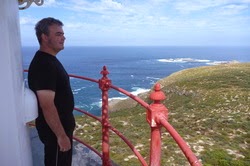This is a really interesting history of what are called rock-lighthouses, those built not on a mainland patch, or on something definable as an island, but on reefs or rocks, often out at sea, but not always. The author is a building conservationist with a strong interest in engineering. So the fascinating history of these special places, often so extraordinarily battered by the elements, is taken up from those points of view. The first of them, Eddystone, was originally a late 17th century ornate wooden tower with extending wrought-ironwork, including a weathervane, designed by the infamously impractical Henry Winstanley, and, in a sense anyway, lionised in the Victorian period through Jean Ingelow's epic poem. Of course, it was blown to smithereens within a few winter gales, and Winstanley with it. Subsequently, the keystone design went through various revolutions, ending with the tapering shape we know so well today, and the stone construction. What interests me is the perfected design having the stone sections all purpose-created with interlocking shapes, both vertically and horizontally, to make as sure as we can of steadfastness - no square mortared blocks here. Nancollas even managed to visit a couple of the remaining ones - all automated now of course - with permission to go inside, and came across the vestiges of the interior style of prior times: specially-designed curved bunks and dressers, ornate mouldings, mosaic floors and so on. Sad to think of all that beauty, now cut through of course with the wiring conduits and suchlike of automation, sitting way out at sea and not appreciated often by human eyes, as was intended. As a writer, he's an unusual mixture. Every now and then will come a really strong piece of beautiful phrasing. Most of the time, his style is reasonably straightforward, though there is a somewhat overused tendency toward the symbolic - lighthouses becoming markers of all sorts of things, their significance toyed with to outline any point currently to hand, which feels a little heavy-handed. And the recent curse of hyperbolization does creep in from time to time: calling a lighthouse finished in the 1880s "barely two centuries old" is a bit much. But, as a revelation of the otherworldly romance of these places, and the contrasting practical exigencies of keeping them standing strong, this little book is a pleasurable excursion.
Tuesday, December 29, 2020
Friday, December 11, 2020
Commonplace Book
'...Others tried to avert personal attacks by discussing war and peace in the abstract, adducing uncertain historical parallels and wondering academically whether it was wise to aim at humiliating a great country too much; were we not sowing the seeds of future wars?'
from Sonia Married by Stephen McKenna (Chapter Five, part III)
Subscribe to:
Posts (Atom)
